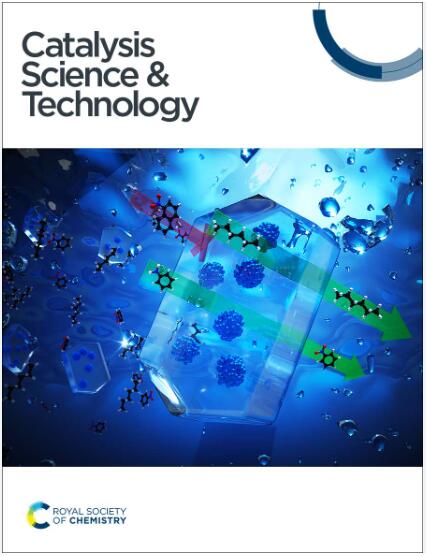Hydride-species-induced enhancement of CO2 hydrogenation selectivity on Ru-atom-modified CeO2 catalysts†
IF 4.4
3区 化学
Q2 CHEMISTRY, PHYSICAL
引用次数: 0
Abstract
Controlling product selectivity in heterogeneous catalytic reactions remains challenging, and elucidating the catalyst structure is essential for modulating the reaction selectivity. In this work, mono- and diatomic catalysts with various Ru geometries were tuned to achieve selective hydrogenation of CO2 to CH4 or CO. Experimental (such as in situ diffuse reflectance infrared Fourier transform spectroscopy (DRIFTS) and density functional theory (DFT)) results show that heterolytic H2 dissociation occurs at the O–Ov sites on the Ru1/CeO2 surface to produce hydride (H−) species; the resulting H− species promote the selectivity of the CO2 hydrogenation to form CH4 at the Ru site via the formation of HCOO* intermediates. In contrast, homolytic H2 dissociation to produce two Ru–H species on the Ru2/CeO2 surface facilitates the selective hydrogenation of CO2 to form COOH* intermediates, which generate CO. This work not only deepens understanding of the mechanism of CO2 hydrogenation but also provides a novel strategy for developing Ce-based catalysts with high selectivity for CO2 hydrogenation.
氢化物诱导的ru原子修饰CeO2催化剂对CO2加氢选择性的增强
控制非均相催化反应的产物选择性仍然是一个挑战,阐明催化剂结构是调节反应选择性的必要条件。在这项工作中,调整了具有不同Ru几何形状的单原子和双原子催化剂,以实现CO2选择性加氢为CH4或CO。实验(如原位漫反射红外傅立叶变换光谱(DRIFTS)和密度泛函数理论(DFT))结果表明,在Ru1/CeO2表面的O-Ov位点发生异解H2离解,产生氢化物(H−)物种;生成的H -物质促进了CO2加氢通过HCOO*中间体在Ru位点形成CH4的选择性。相反,在Ru2/CeO2表面,H2均解离生成两个Ru-H,有利于CO2选择性加氢生成COOH*中间体,从而生成CO。这项工作不仅加深了对CO2加氢机理的理解,而且为开发具有高选择性CO2加氢的ce基催化剂提供了新的策略。
本文章由计算机程序翻译,如有差异,请以英文原文为准。
求助全文
约1分钟内获得全文
求助全文
来源期刊

Catalysis Science & Technology
CHEMISTRY, PHYSICAL-
CiteScore
8.70
自引率
6.00%
发文量
587
审稿时长
1.5 months
期刊介绍:
A multidisciplinary journal focusing on cutting edge research across all fundamental science and technological aspects of catalysis.
Editor-in-chief: Bert Weckhuysen
Impact factor: 5.0
Time to first decision (peer reviewed only): 31 days
 求助内容:
求助内容: 应助结果提醒方式:
应助结果提醒方式:


